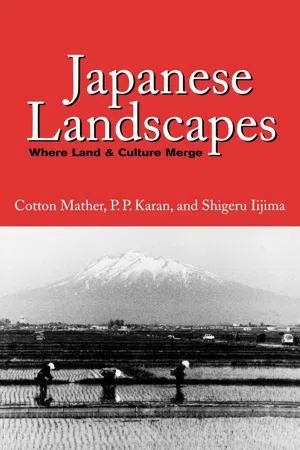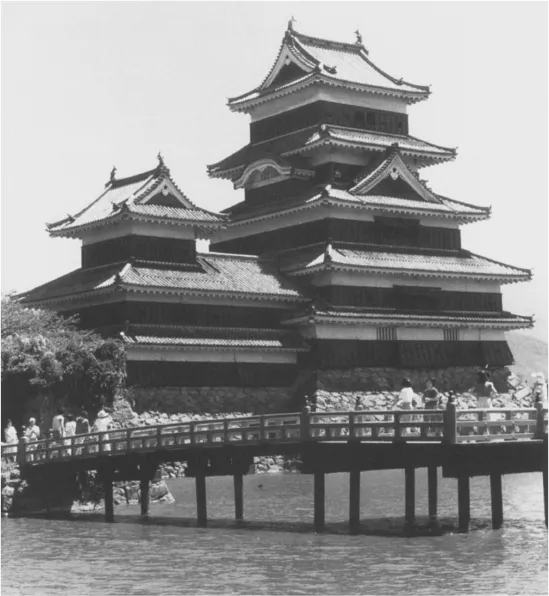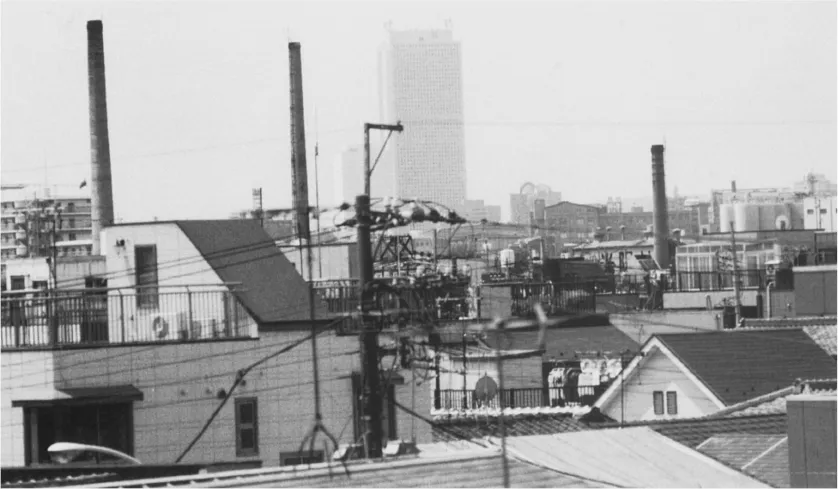![]()
The General Landscape
CHAPTER 1
LANDSCAPE IS A VISUAL SCROLL which provides insights into the nature of a people and their cultural impress upon their environment.
Landscape is the interaction of culture, time, and geographic space. It records what has happened. It is an eloquent transcription of the physical history and the essence of life as it functions in a complex matrix. Landscape is the unvarnished etching of the past and present, of reality. It expresses the values and social forces associated with a culture that have shaped the environment. Our understanding of an area and of human relationships with the environment are really cultural expressions which define place and space. This is landscape, the consequent compage of the elemental bonds of land and culture.
The landscape of Japan commands special attention, for it is extremely complex and intricately organized. It is the occupance record of a culturally distinct and dynamic society on an archipelago bordering the earth’s largest continent and on the brink of a 35,000-foot-deep ocean trench. Great tectonic plates collide in this zone, resulting in earthquakes, tsunamis, volcanoes, and hot springs. The land is indeed alive and so is the distinctive culture of the people.
Geography spared Japan the tramp of invading armies and the confusion of many intruding aliens with strange cultures and ways. The Korea Strait, which separates Kyushu, the westernmost island, from the nearest part of the Asian mainland, is 100 miles wide, and although it has sizable steppingstone islands, it was difficult and dangerous to cross in early times. The barrier strait gave Japan a semi-isolation, placing it within the Chinese culture area and at the same time setting it apart. During certain periods a broad stream of ideas, literature, art, religion, and philosophy flowed from China to Japan. At other times the flow was shut off from one side or the other, and Japan developed on its own. But whether in isolation or not, Japan was always itself. Thus, the Japanese had more opportunity than most peoples to develop to the fullest their distinctive culture: everything that came from outside was reshaped to suit Japanese tastes and needs. The mixture of subtlety and sophistication, as well as the delicacy and complexity in this culture, bear testimony in the landscape. The balance between driving ambition and aesthetic sensitivity is clearly evident.
Japan has been inhabited for thousands of years. Northern Kyushu, because of proximity to the Asian continent, became the site of its first political center. By the fourth century A.D. a sovereign court had emerged, which by conquest and alliance eventually unified the country as a nation-state. In the seventh century a unified Japan consisting of Kyushu, Shikoku, and Honshu was established. Hokkaido was settled by the Japanese between 1600 and 1868.
Until the mid-nineteenth century Japan was divided administratively into a system ruled by daimyo or feudal lords. After the Meiji Restoration (1868) the country was reorganized into prefectures. At present Japan is divided into forty-seven prefectures. But the Japanese consider them too numerous and newfangled to bother about much in ordinary conversation. They more often speak of historic vernacular regions, corresponding in America, perhaps, to New England or the South. There are eight of these regions: Hokkaido, the northernmost island; Tohoku, northern Honshu; Kanto, Tokyo and the Kanto Plain plus environs; Chubu, the plump middle of Honshu, including Nagoya, Mount Fuji, and the Japanese Alps; Kinki, centered on Osaka, Kobe, and Kyoto; Chugoku, the western end of Honshu, including Hiroshima; and the two other islands, Shikoku and Kyushu.
For nearly two thousand years, an emperor or an empress belonging to the same family as Akihito, the present emperor, has ruled or reigned over Japan. Beginning in the twelfth century, a series of military shoguns seized and exercised real power in the name of the emperor. The shogunate of the Tokugawa family, who governed from 1603 to 1867, sealed Japan from the rest of the world and left the most definitive imprint on the country.
The ancient landmarks of Japan include old roads, old temples, and old castles. Historic roads such as the Tokaido and the Nakasendo connected Kyoto with Edo (Tokyo), and the Kokurikudo joined Kyoto with Tohoku via the coast of the Sea of Japan side (formally called Ura Nihon, backside of Japan). Many old stage towns (shukuba-machi) developed along these roads. In 1987 there were more than 81,350 Shinto shrines and 77,000 Buddhist temples. Old castles were originally military fortifications designed to provide protection against enemy attack. With the rise of feudalism, they became a distinctive architectural form serving as both a palatial residence and a seat of military and political power. The daimyo built castles in the center of their domains. Each castle included residences of the castle lord and his chief retainers. Fortifications such as stone walls were built and moats were dug. Around these castles developed castle towns (joka machi), the characteristic form of Japanese city until the Meiji Restoration of 1868 (FIG. 1).
1. Matsumoto castle lies in the center of Matsumoto Basin, Nagano Prefecture. It is an impressive example of castle architecture in Japan, and it is the oldest five-tiered donjon in the country. The castle was built in A.D. 1504, during the warring states’ period. Beautiful cherry trees line the moat. Matsumoto city developed as a castle town. In spite of modernization in the city center, Matsumoto retains much of its heritage as a prosperous castle town, especially along its charming back streets. This old castle town is now an educational, industrial, and cultural center.
Today, however, Japan bears the overwhelming imprint of a bustling, populous, modern society that is finely attuned to severely limited areas of favorable terrain. The legendary Tokaido corridor, which runs from Kyoto to Tokyo along the underbelly of Honshu, once a romantic route it is now a megalopolis, similar to the Boston-New York City-Philadelphia-Washington urban belt. Here the landscape is dominated by hillsides with highway cuts, television antennas like a skyful of spiders, factories, tall smokestacks, wide-flung railroad yards, and electric power lines that march across the countryside every which way, with poles and towers carrying as many as twenty cables (FIG. 2). It is landscape festooned with wire. On the tops of factories—many of them bright, clean, and modern—signs such as Sony Hi-Fi, Meiji Chocolate, and Kirin Beer shout the temptations that have replaced the complaisant maids of the old inns in stage towns.
2. Urban skyline of Shitamachi district of eastern Tokyo, which developed in low-lying areas on the western side of the Sumida River. Inhabited by merchants and craftsmen in feudal times, the old neighborhoods in Shitamachi have survived to the present day, with small-scale merchants and artisans clustered in traditional commercial neighborhoods. It is a distinctive area of Tokyo, distinguished in terms of geography, historical background, social and cultural traditions, social identity, and economy. Shitamachi was largely the product of rigid segregation imposed on the mercantile and manufacturing classes by the feudal elite during the Edo period (1615-1867). Today it is inhabited by members of the old middle-class shopkeepers, artisans, wholesalers and industrial subcontractors. The skyline with old and new buildings and smokestacks of factories is dominated by the sixty-story, 800-foot-high Sunshine City Building near Higashi Ikebukuro Station. Some of the fastest elevators in world, traveling nearly 2,000 feet per minute, take visitors to the top of this office, hotel, entertainment, and commercial complex.
3. The superfast Hikari express train of the Shinkansen system at Kyoto Station. The distance of a little more than 700 miles between Fukuoka and Tokyo is covered in about 5 hours and 51 minutes by Shinkansen. It is called “bullet train” because of its speed and shape. A Shinkansen train departs Tokyo for Osaka or some point farther west every seven minutes throughout the day, from 6 A.M. to late in the evening. Between the inauguration of service in 1964 and early 1991, the Tokaido Sanyo Shinkansen carried 3 billion passengers. The Tohoku Shinkansen, from Tokyo to Morioka, commenced service in 1982. Travel time between Tokyo and Osaka, the 311-mile-long urban-industrial corridor of Japan, was reduced from 6 hours and 30 minutes to 2 hours and 30 minutes by Shinkansen, an improvement that considerably altered business activities.
Without doubt the Tokaido is one of the world’s busiest traffic corridors, for through it run the old road, unrecognizably rerouted and remodeled for car traffic, a new expressway, the Japan Railways’ original Tokaido Line, and the bullet train route (FIG. 3). Both rail routes go through the mountains at Hakone in separate four-mile-tunnels. The corridor forms one huge, stretched-out city, with little open countryside anywhere along the route.
Although the land of Japan has traditionally been densely settled, its natural beauty has never been overrun. Rather, every available plot of ground has been cherished. Forests have been cultivated as carefully as rice fields, and each tree grows in its place because someone intended it to be there. The people revere the land and protect it. Some spots are famous for their view of a moonrise, others for the turbulence of surf churning around rocky islets. Even Japan’s violent aspects—its storm-beaten coasts and fiery volcanoes—are goals of pilgrimage. Honor for nature is so ingrained in the Japanese that they would not fail to pause and contemplate the colors of leaves and blossoms.
Four islands—Hokkaido, Kyushu, Shikoku, and Honshu—constitute 95 percent of Japan’s area. Kyushu is separated from Honshu’s western headlands by a strait no wider than the length of a tanker. In similar propinquity, the island of Hokkaido nearly touches the northern cape of Honshu. Little Shikoku nestles under western Honshu and thus serves to enclose the scenic and tranquil waters known as the Inland Sea. The nation’s total area of 377,688 square kilometers (145,825 square miles) is just one-twenty-sixth the size of the United States, yet Japan’s population, 123.6 million, is approximately one-half that of the United States. But the Japanese problem of living space is far more constraining than these figures suggest. Nearly 73 percent of the land is mountainous, and about 14 percent is arable. Moreover, the patchy distribution of arable land is difficult to connect (see Map of Japan on page xi). Yet on this small lowland total rests most of Japan’s population, industry and agriculture. In 1990 the density per square mile was 128 persons. Comparable figures are 139 in the Netherlands and 125 in Belgium. The density of the Japanese population per unit of area under cultivation is the highest in the world. Since 1950, however, there has been a strong tendency toward regional concentration. population. As a result, more than 50 percent of the Japanese live in the densely populated areas surrounding the three major urban centers of Tokyo (the Kanto Plain), Osaka (the Kinki Plain), and Nagoya (the Nobi Plain). The Tokyo Metropolitan Area, in particular, though less than 2 percent in terms of area, has a concentration of nearly 24 percent of the national population. Nationally about 60 percent of the total population resides in 3 percent of the total land area of the country.
Japan’s challenge is basically to organize itself compactly, three-dimensionally, efficiently, and connectedly and to provide a high economic return, a high standard of living, and a long life expectancy. This Japan has done. It now has the highest average life expectancy in the world, the world’s largest source of investment capital, and the highest per capita income in Asia. Furthermore, despite its limited land, Japan is the second largest economic power on the planet.
The Japanese landscape manifests the nature of this accomplishment in the contrast of old and new landscapes. While Japan has a very limited area, the four major islands represent a huge latitudinal stretch; the distance from Kyushu to Hokkaido is comparable in latitudinal extent with that from Florida to Québec. If the Japanese islands were overlaid on the Atlantic coast of North America, they would extend from Tallahassee to Montréal.
Visitors often give diverse reports on Japan’s climate. This is not surprising, in view of the great latitudinal range of the country plus its varied terrain and its elevational complexity. In addition are the remarkably sheltered borderlands of the Inland Sea that are so noted for sunny weather and the lowest relative humidity in the nation. At Okayama, for example, bright sunshine prevails on more than half of the days in every month. Okayama, about 100 miles west of Osaka, has 129 rainy days per year compared with 227 on the Japan Sea side of Honshu at Niigata.
The thermal range that one might anticipate from the great latitudinal stretch is accentuated by the marked monsoonal factor. Prevailing northwesterly winds spiral outward from continental Asia in winter, and in summer s...



